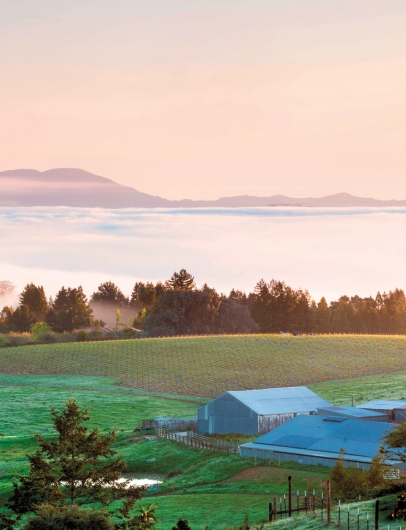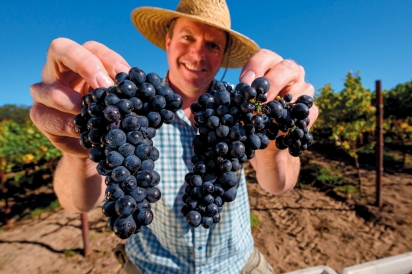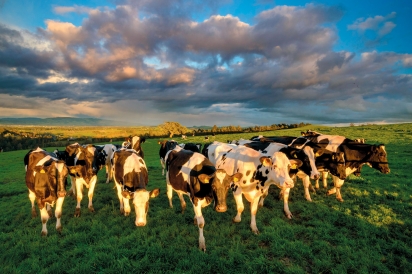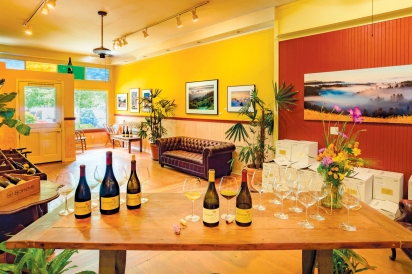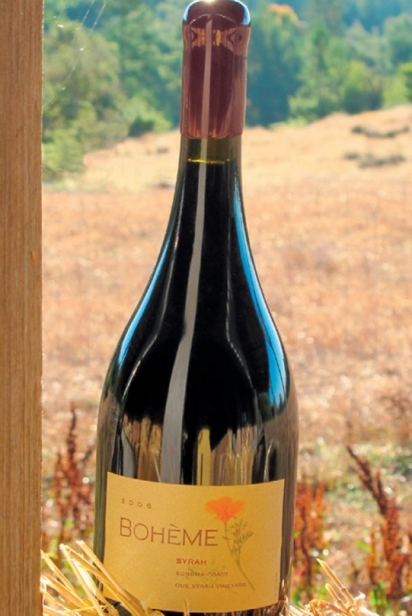Kurt Beitler's Boheme Wines
A BOHEMIAN STREAK RUNS THROUGH THIS SONOMA COAST VINTNER AND HIS WINES
The story of Kurt Beitler and his Bohème wines begins in the earliest days of California’s wine history. One of Beitler’s ancestors was the director of Napa’s Beaulieu Vineyard’s first vintage in 1900. Another was the winemaker for Inglenook, also in Napa’s Rutherford AVA, in the early 1900s. In 1972, his wonderfully spirited grandfather, Charlie Wagner, founded Rutherford’s iconic Caymus Vineyards. Beitler’s uncle, Charlie’s son Chuck, started the Conundrum and Mer Soleil brands. On Bohème’s website, though, there’s nary a mention referencing Beitler’s lineage.
Driving the backroads of the southern Sonoma Coast, Beitler is showing me his trio of leased vineyards, all windy and poor-soiled (both qualities excellent for making lower-alcohol, balanced Pinot Noirs and Chardonnays). When I ask what may have been a sensitive question, the 41-year-old with apple cheeks and a toothy grin becomes existential.
I mention that I had I read a prominent article about Sonoma Coast wines, and rudely point out Bohème’s exclusion, and “Didn’t that piss him off?” He thinks about it, then answers, “That’s a cheap and selfish emotion and I don’t want to give it the attention. People who pursue acknowledgement are poor souls and spend less and less time with their wines.”
About 20 minutes later, apparently after contemplating the notion of self-aggrandizement, he picks up the thread, “Because of my family heritage, it would make me feel small [to seek recognition]. I want my wines to stand on their own.”
They do.
I’ve been writing about California wines for almost three decades, and find many too sweet due to high alcohol, over-ripe fruit and too much oak residue. Not Bohème’s. Beitler’s single-vineyard bottlings—priced at around $50—have pretty but restrained fruit; all are balanced by a definitive strand of acidity and are delectable with food. The price tag might at first seem excessive, but as these things go, Beitler’s wines are world-class, in short supply and worth considerably more given their excellence.
Bohème produces only about 1,500 cases per vintage, and that’s in a good year on the perpetually rugged coast. His troika of vineyards (soon to be four)—English Hill, Taylor Ridge and Stuller— produce grapes with somewhat disparate attributes derived from their particular terroir. For instance, while grapes from one might contribute salty, licorice flavors, others may be more floral and grapes grown on the third might display more fruit or less acidity.
Beitler maintains a style that keeps the wines in check—no trifle, given the often-harsh conditions the coastal terrain bestows, which at once can be damning and a blessing. That is, they are exquisitely flowery, delicate on the palate and always have spritely acids that are as brisk as they are cleansing. Bohème Chardonnays and Pinot Noirs are in the 13.5 to 14.3% alcohol range—low by California standards. When conditions bring lots of rain, cold and searing winds, the fruit can hold back its sweet delights, thereby elevating the acid levels to puckery-ness. But in the hands of a sensitive soul such as Beitler, the results can be gorgeous.
Part of the beauty of growing grapes close to the ocean, he explains, is that there’s a long growing season without accumulating sugars fast, and the wines are able to maintain complexity. “There’s a lot of pressure on New World producers for explosiveness, and Pinot Noir is no exception. Many take great pains to darken the wines, concentrate the flavors, soften the acidity.”
Beitler started Bohème about 16 years ago with hardly a notice. It wasn’t until 2015 that he opened a tasting room on the Bohemian Highway in Occidental. The tasting room offers the opportunity to really learn about Beitler and his wines and, it seems, people are starting to catch on.
Don’t misconstrue the winemaker when he says in earnest, referencing his pedigree, “I definitely desire my wines to have very broad respect … [but] my view on how to get there is to carry some modesty.” He sees himself as an Old-World maker of wine who is “totally involved and addicted to growing grapes. I love it.”
“It’s beautiful work,” he says, illuminating his labor. “There’s countless opportunity for creative expression; a depth to the work. As a grower, you own it, whether it’s a successful year or a loss. You’re hooked and all-in and you have to have your head in the game. You need to love the vines; vineyards respond to human interaction. And it follows that that person will be in and among the vines, asking, ‘What are their needs?’”
To encourage biodiversity in the soils, he uses no herbicides, which “demands much greater hand work.” He also practices minimal tillage. This approach, he explains, aside from encouraging vine resilience, allows greater nuance, depth and expression of the site in the wine.
His Taylor Ridge Vineyard, an area of five acres planted 18 years ago, lies at an elevation of more than 900 feet and is about five miles from the Pacific Ocean. It’s the coolest of Bohème’s three vineyards. Specific nutrients come from what was once the Wilson Grove Sea, which covered western Sonoma County. A clay subsoil retains moisture late in the growing season, Beitler explains, allowing him to dry farm. That, in turn, along with the fog, contributes to the acidity of the wines.
English Hill Vineyard grows on a hilltop at about 600 feet and is nine miles from the ocean. The narrowly spaced 8.5-acre parcel, planted 14 years ago, is comprised of nine Pinot Noir plots, one Chardonnay and one Syrah. Overlooking Tomales Bay and the Marin Hills coastal range, the weather is turbulent and the vines exposed. On summer mornings, fog engulfs the spot, covering the foliage with ocean mist. Afternoon winds dry the canopy and deposit flecks of soil in the folds of the leaves.
English Hill also sits on land that for more than 100 years was used for pasturing cattle. According to Beitler, “The years of grazing before we planted have dramatic influence on the vines.”
No doubt due to those years of natural fertilization, Beitler says he has had to apply zero nutrients or compost, and “the vines grow green and with fantastic vigor. I absolutely credit the soil health to the years of manure composting from the Poncias’ cows.” The Poncia family, whose cattle still range in an adjacent pasture, has been ranching in the area since the late 1800s. The ranch is incredibly windy and foggy and “for a few years before our first harvest, I had major concerns we were too close to the ocean,” he says. “Would we have a crop? And would it make exceptional wine?” It does.
The 18-year-old, six-acre Stuller Vineyard grows amid redwoods, on a coastal ridge at 1,200 feet, with views to the Pacific approximately six miles to the west. The idiosyncrasy of Stuller is its soil diversity, which led to the planting of two separate plots. The vines are stressed and have low vigor; with each producing just ounces(!) of fruit.
Bohème’s 2015 Chardonnay from English Hill, for instance, is a perfect example of how a California Chard can display similar characteristics to wine from the Chablis region of France, a cooler area than the rest of Burgundy, that produces some of the greatest white wines of the genre. Here, the telltale sign is the Bohème’s backbone of honey qualities, whose sweetness is restrained because of the palate-cleansing acidity and which may be long-lived.
That acidity—oh, the acidity—is the reason I love Beitler’s wines so much. A signature of many Sonoma Coast wines, bracing acidity is what keeps Bohème’s wines bright, crisp and refreshing.
BOHÈME WINES GO WELL WITH:
I adored Beitler’s 2014 Bohème Taylor Ridge Pinot Noir and will, in time, sink my teeth into the ’15. While the former was perfumed with cloves, flowers and anise on a silky structure, the latter is more austere, no doubt due to the cooler growing season, which, not incidentally, resulted in the production of only 105 cases. That is down by more than half from the previous season.
The 2015 Bohème Taylor Ridge Pinot Noir is fairly opaque with violet edges (foretelling its youth). It is redolent of wild cherries with a hint of raspberry and some savory-ness, reminiscent of dried herbs and a small degree of stewed meat (a good thing, me thinks, because that only adds to its charm). There’s everything you’d want here in a Pinot: sturdy sweet fruit and elegance that is not overwrought. Hold onto it for a year or two to allow it to settle and then drink over the next 10.
The wine would go wonderfully, for example, with the sausage-stuffed guinea hen I had not long ago at Canneti Roadhouse Italiana in Forestville, just down the road from Bohème’s tasting room. The bird’s sweet skin was made even more so by the accompaniment of stewed caramelized onions, a perfect foil for this wine.
Canneti’s chef, Francesco Torre, thinks his friend Beitler’s Pinot Noir also goes well with the boar stew he serves on Thursday’s “locals night.” The acidity and dried cherry flavors of the wine “somehow make the stew lighter with its earthiness and enlivens it,” says the chef.
We’re pleased you stopped to read the first installment of Wine Matters, a commentary regarding matters of the world of wine and why wine matters.


